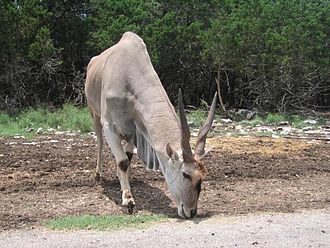The giant eland is a species from Africa. It is broken into a western and eastern subspecies.
It is important to note, that the “giant” in its name refers to its longer horns, not to the animals size -the eland is already the largest antelope in Africa.

It is generally found in open forests, and savannah ecosystems. They eat grass, as well as browsing branches and leaves. They will often form herds of 15-25 members.
It is said to be found across a wide range of countries, including Cameroon, Central African Republic, Chad, Democratic Republic of the Congo, Guinea, Mali, Senegal, and South Sudan, as well as Guinea-Bissau and Uganda. It is also found in the Jos wildlife park in Nigeria. Having said this, it is thought that there are only 170 western giant Eland that remain and these are found in Niokolo-Koba National Park which is in Senegal. The eastern giant Eland is in a better position with around 15,000 Eastern giant Eland left in the wild. 12,500 of these Eastern giant eland live in the Central African Republic. In South Sudan, the Southern national park is thought to have around 165 of these animals still surviving.
The eastern giant eland is conserved in the Faro National Park, Bénoué National Park, Bouba Njida National Park, Bamingui-Bangoran National Park and Manovo-Gounda St. Floris National Park.
It is locally extinct in Gambia, Ghana, Ivory Coast and Togo
The eastern giant Eland is considered least concern (though the population is declining)
The western giant Eland is considered critically endangered with only 200 remaining in the wild. These are all found within Niokolo-Koba national park, which is an important reserve, but not well protected. This reserve also hosts small numbers of western lions.
It would seem a sensible thing to translocate eastern giant Eland into western Africa, but it is quite possible that nothing like this will happen as there are still western giant Eland in the wild. 200 is a good basis for recovery of the species – as much as 100 calves could be born each year. Should all non-natural pressures end, it is quite possible that withing a decade, the species number could be back above 1000 wild members.
